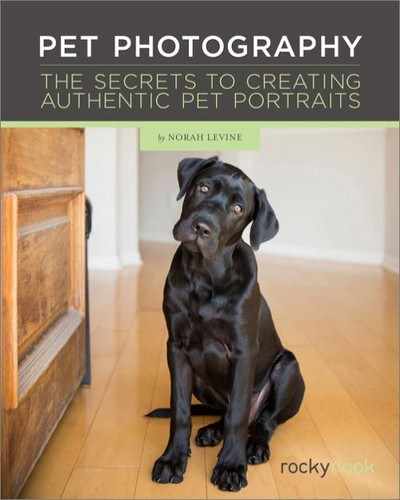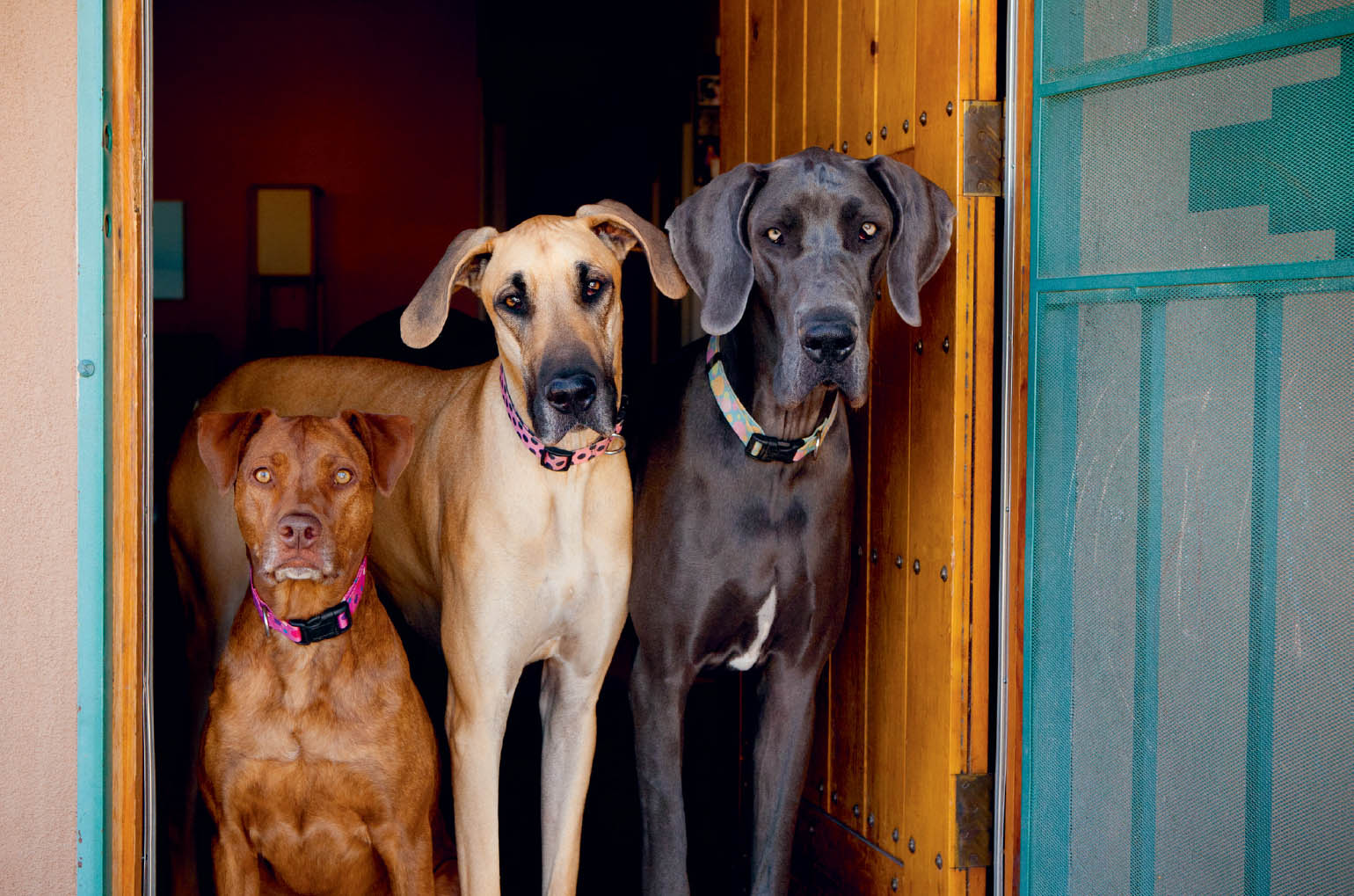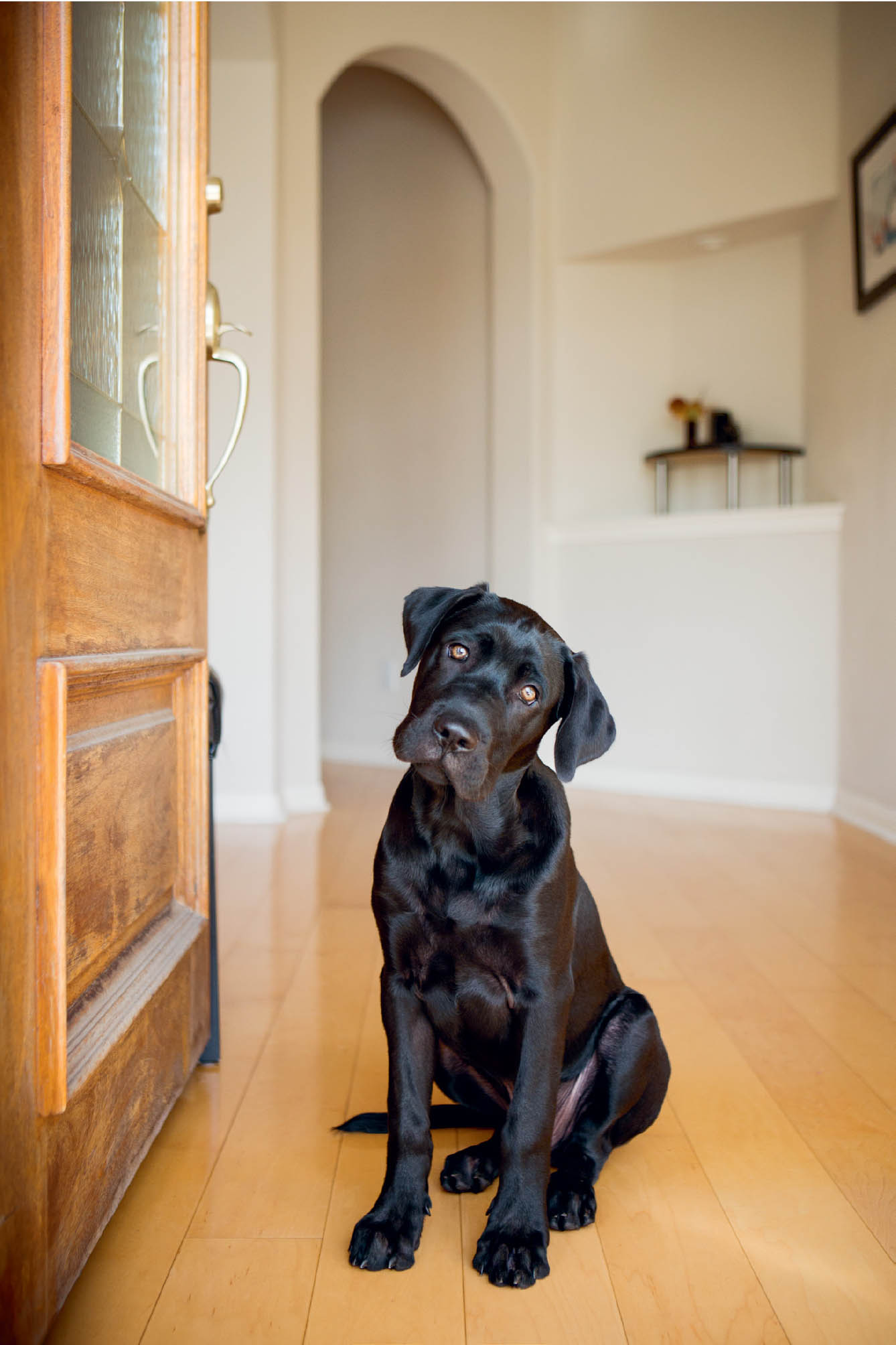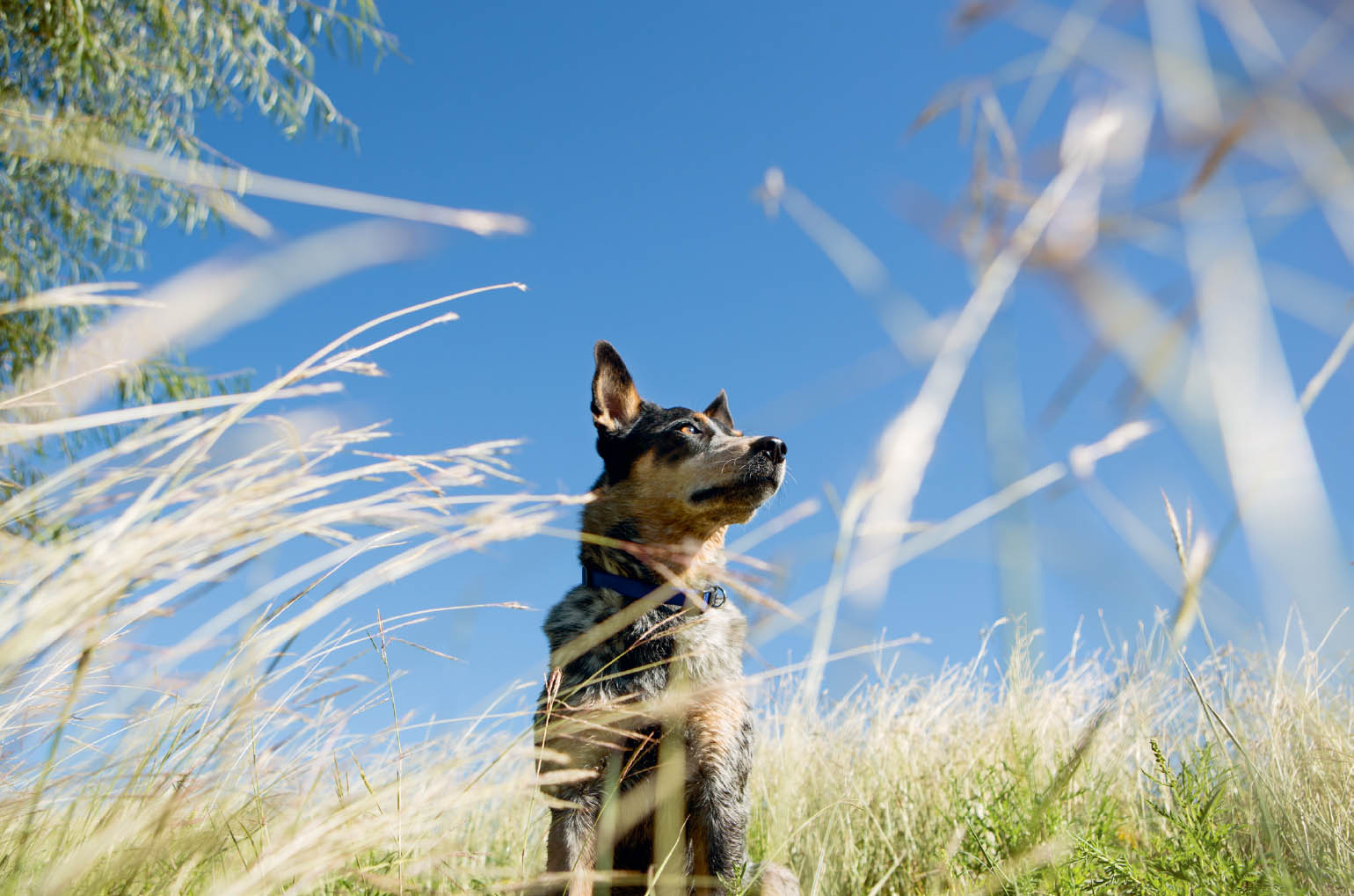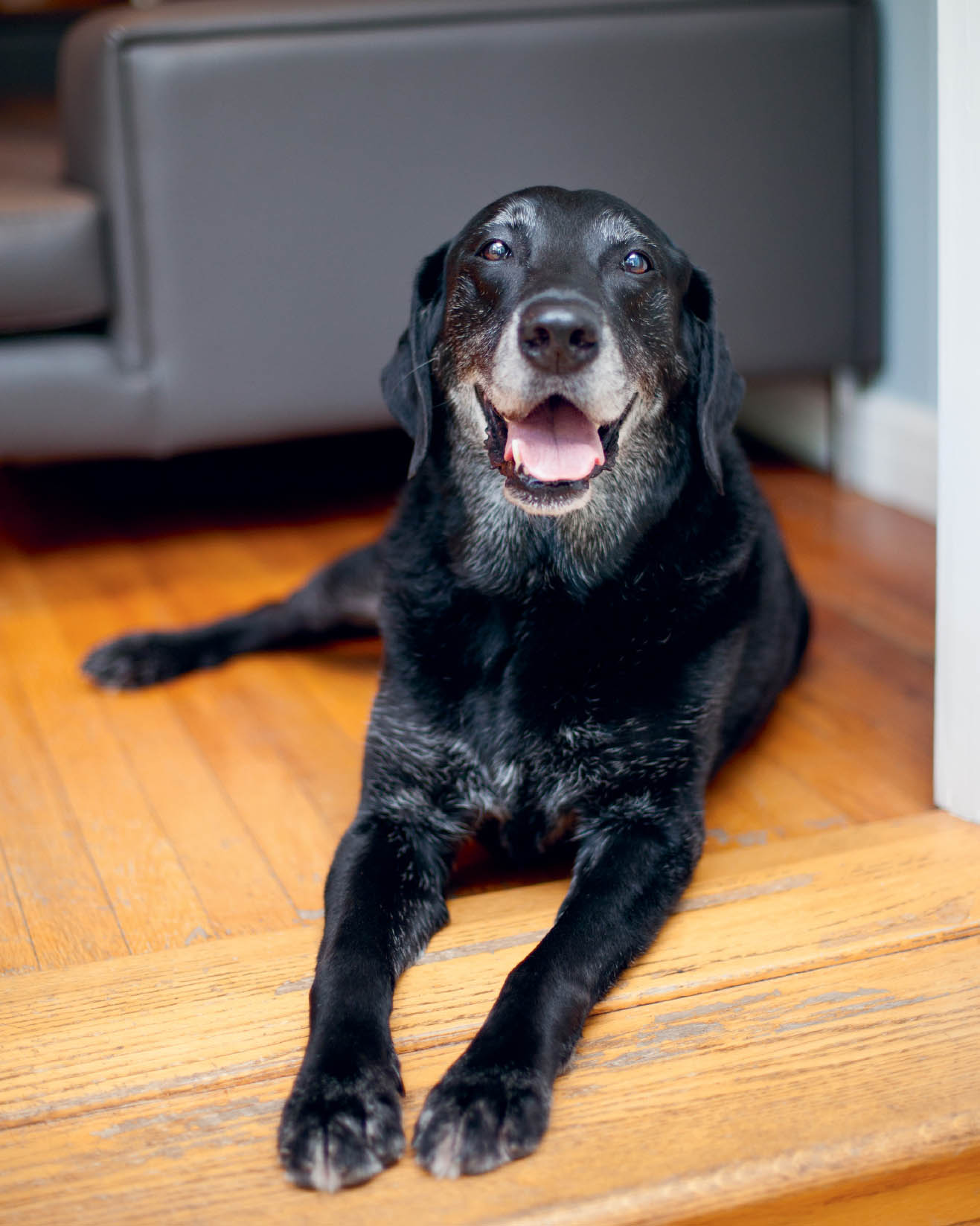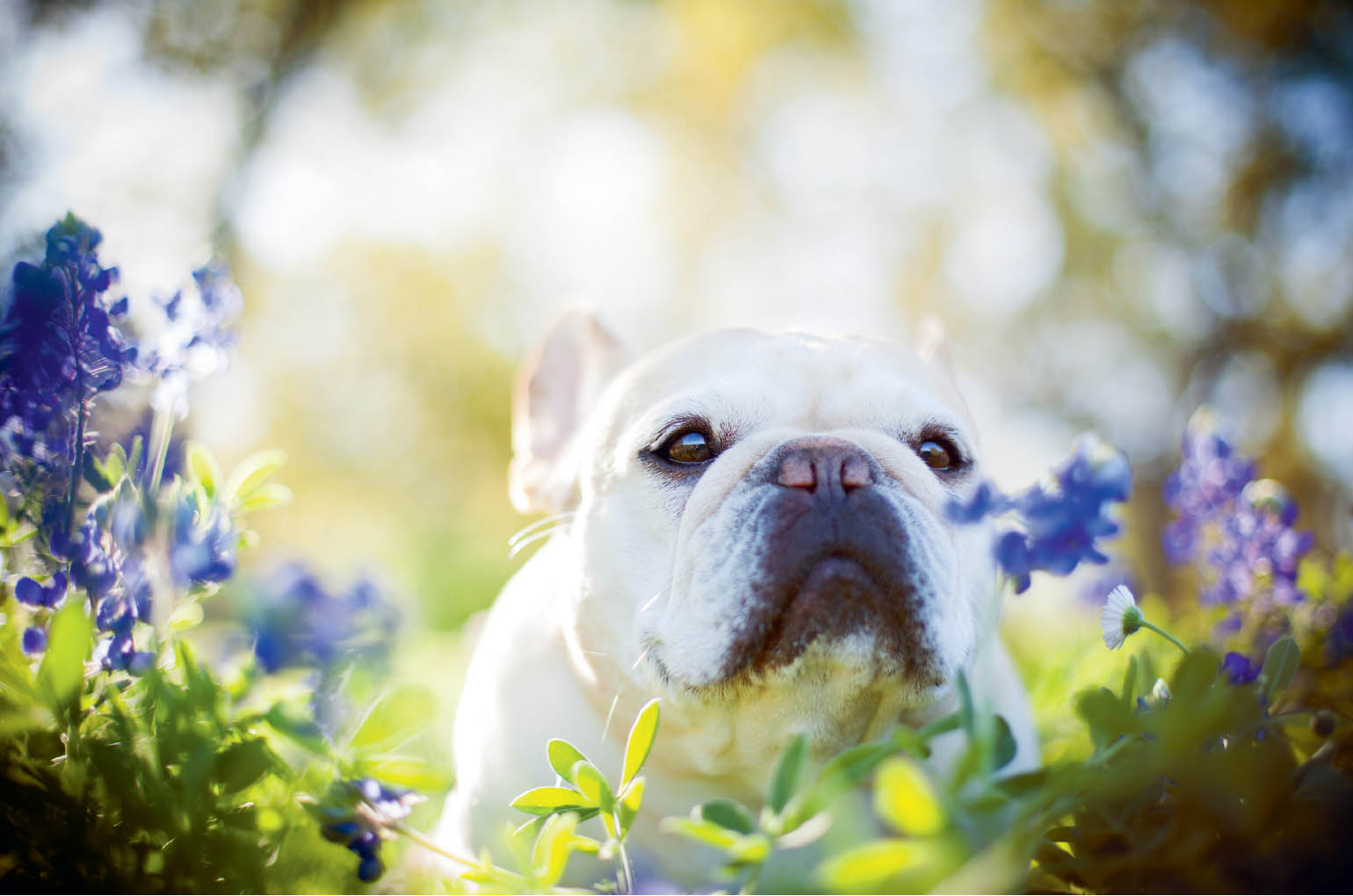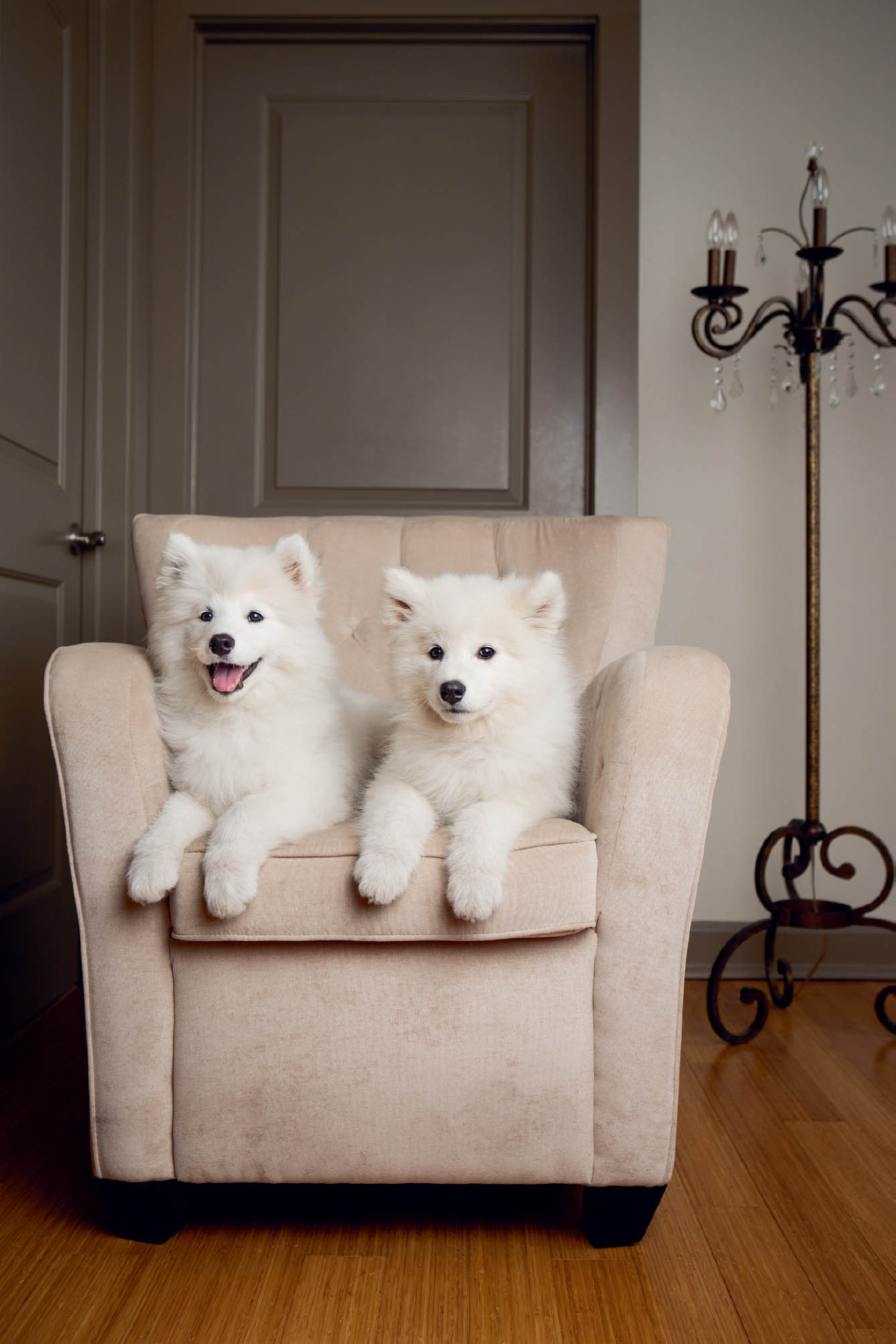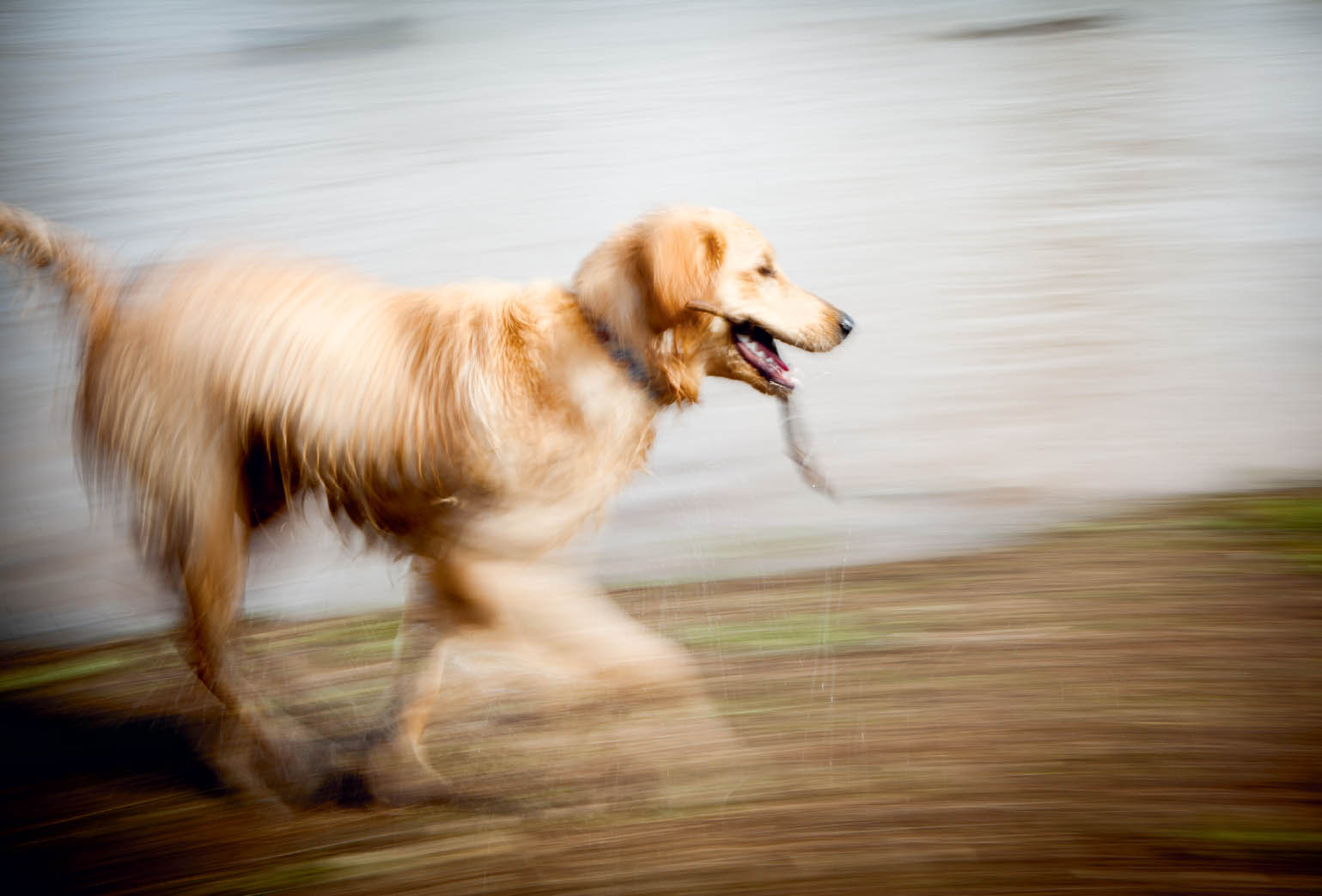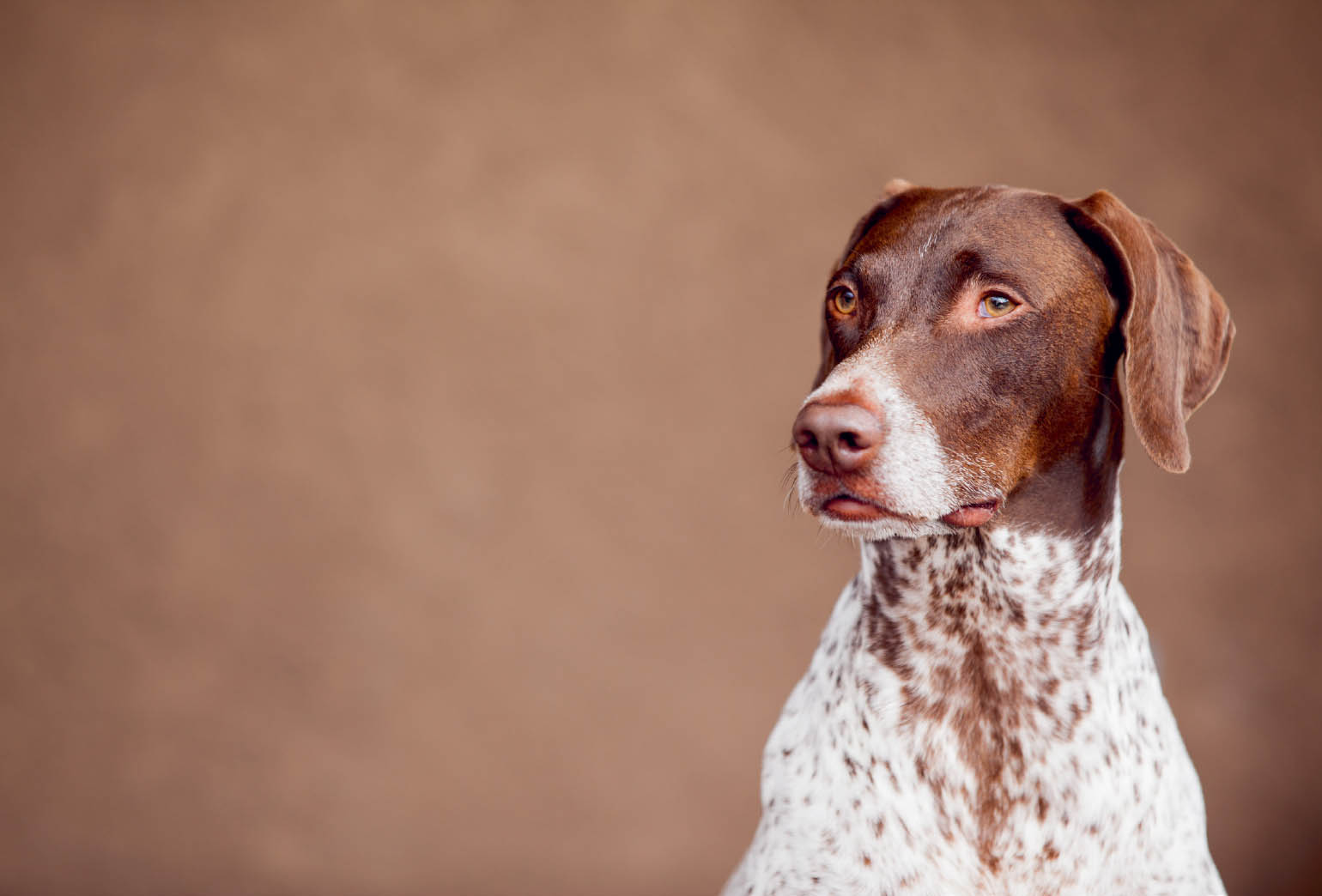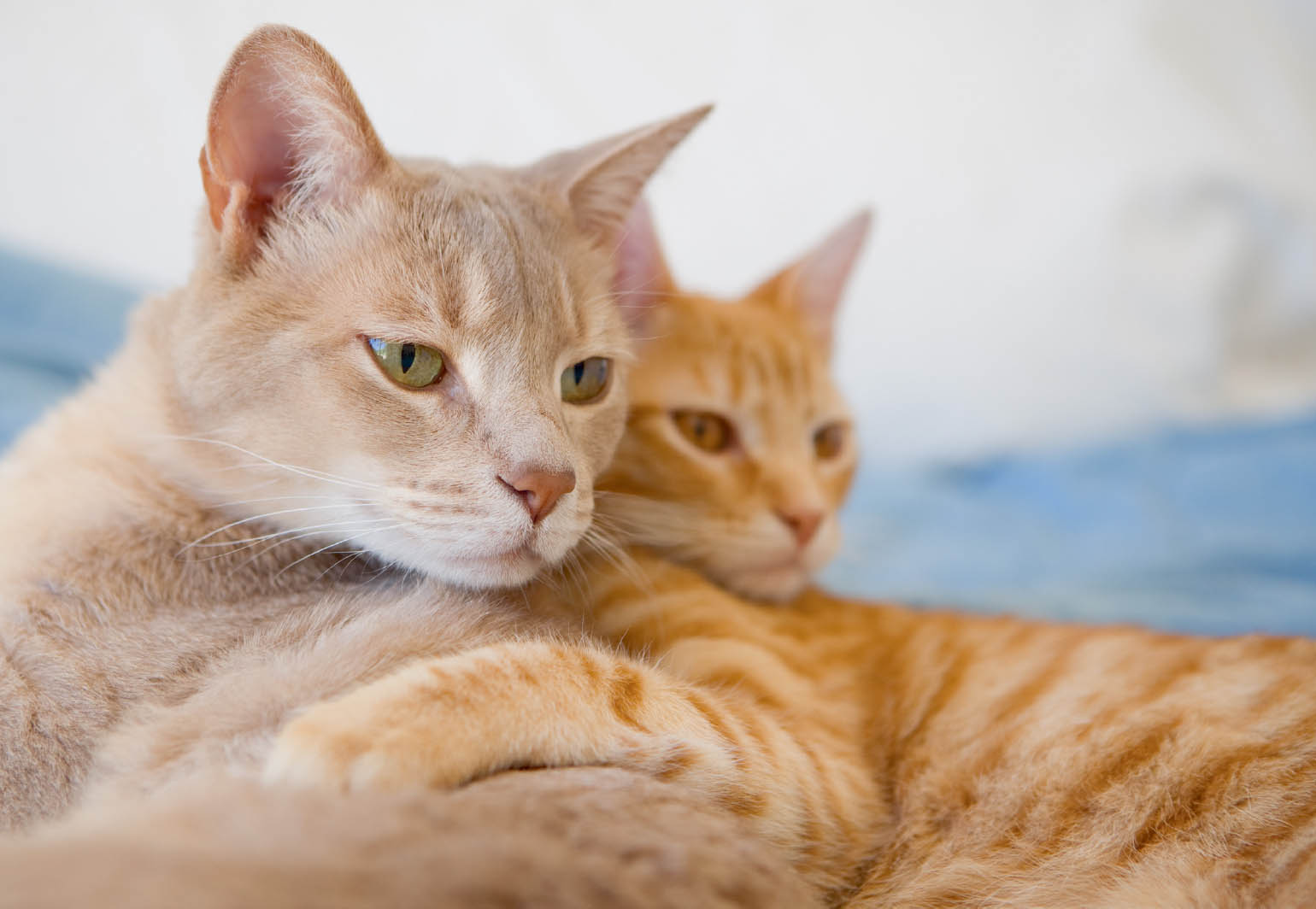CHAPTER 7: PHOTOGRAPHING DOGS
I photograph dogs more than any other type of pet for clients and other projects. Dog portraits have existed in art and photography for many years, and more than ever before, people consider dogs and other pets to be part of the family. I’m grateful for this!
I attribute a huge part of my success as a pet photographer to my understanding of dog behavior and the awareness I’ve cultivated for how to create images and experiences that are personal to my clients. Knowing how to successfully gain a dog’s attention, get creative during the shoot, and troubleshoot challenging situations will significantly improve your ability to create strong dog portraits.
Understanding Dog Behavior
Consider that, as photographers, we approach dogs with a giant “eyeball” and loads of equipment, and an agenda for them to “perform” according to our artistic vision. It’s important to understand their needs and learn to read their communication for this to work well.
Like humans, every dog has his or her own unique character, tendencies, likes, and dislikes. Unlike humans, however, dogs usually share with us how they feel. This communication can be large and loud or small and subtle. If you pay close attention and start to learn about the way dogs communicate, it will help you tremendously with your portraits and editing. You don’t need to be a dog trainer in order to start building an awareness of their behavior, and I highly recommend that you start before you’re in the middle of a photo shoot.
PAY ATTENTION TO BODY LANGUAGE
A dog’s body language provides valuable information about his or her comfort level with you, the environment, and the overall situation. Our goal as pet photographers is to allow the dogs to feel as comfortable as possible, and as a result, we’ll be better able to capture the images we want and stay safe in the process. Note that the purpose of sharing some signs of stress that dogs typically display is to cultivate awareness, not to scare you.
When I am interacting with and photographing dogs, I am looking first at some of the major body language signals, including their eyes, ears, tail, mouth (both physical gestures and verbal), and general body position.
A LARGE PORTION OF A DOG’S COMMUNICATION OCCURS THROUGH BODY LANGUAGE.
I want a dog’s eyes to be soft and relaxed, as they are often an indicator that the dog is at ease. Squinty eyes are typically considered “hard” eyes and will usually tell me that a dog is experiencing stress of some sort or possibly displaying signs of aggression. I never want to stare or point my lens at a nervous or aggressive dog, because this can actually indicate to the dog that I am being aggressive or contentious.
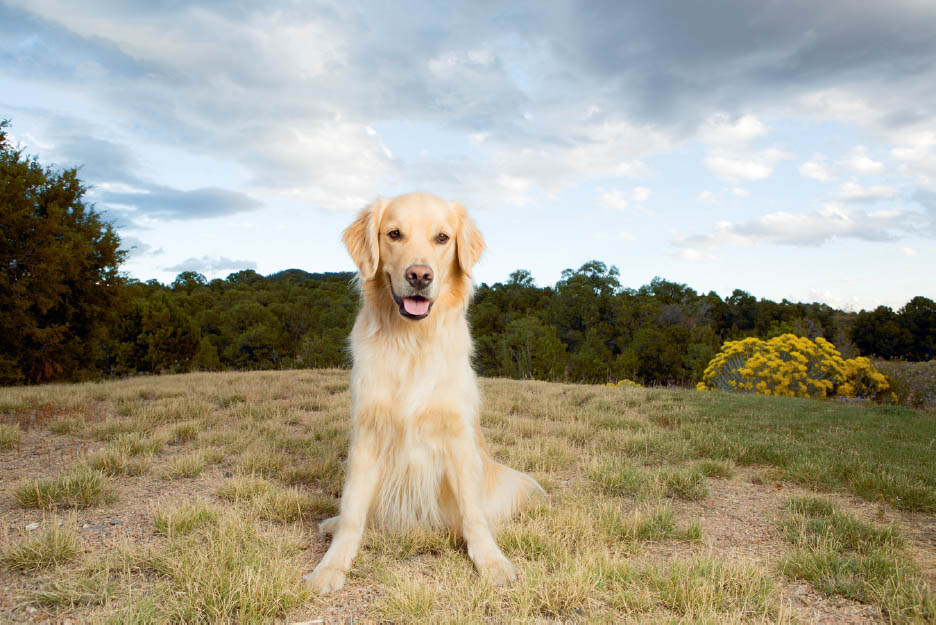
In this image, the dog’s body language is relaxed. Just what we want!
If a dog’s eyes are wide open, even showing a lot of the whites of its eyes, this can indicate that the dog is concerned, stressed, or at the very least, has a heightened state of awareness. Sometimes this happens when treats are introduced—this isn’t necessarily a reaction to bad stress, but it isn’t usually a good look for portraits.
Expressions can change from moment to moment, and as I’m photographing, I can notice these changes from frame to frame. I may capture an image wherein a dog has soft, relaxed eyes; and then in the next frame, the eyes appear squinty and tense. These expressions as captured on my camera aren’t always indicators that a dog is stressed during the entire shoot, but if these expressions persist, I pay close attention and make sure I respond appropriately by taking breaks, providing needed space, or changing some action that may be causing the discomfort.
While you are focused on your own photographic goals, it’s important to remember that your camera, gear, and actions can make some dogs very uncomfortable. (See the “Troubleshooting” section of this chapter for ideas on how to navigate this situation.)

Phillip, the Chihuahua, has ears that always stand up, so I’ll need to look at his eyes and other body language cues to get clear information about how he is responding to the situation.
A dog’s ears will also provide a lot of helpful information about his or her comfort level. Regardless of the type of ears on a dog, I typically want them both looking either alert or relaxed for the images. Some dogs, like German Shepherds or Chihuahuas, have ears that are permanently upright. In this case, physical shifts in their ears are subtler than, for example, a Labrador Retriever’s. Dogs with ears that are permanently standing up can still move their ears, and this impacts the look of the portrait. For example, a Chihuahua’s ears are a bit like antenna and can move around subtly in response to sounds or action. My ideal positioning for dogs with these types of ears is to have them both facing straight forward.
These dogs have floppy ears that are alert and perky.
Floppy-eared dogs have a lot to say with their ears. When a dog’s ears are pinned back close to their head, it usually tells me that the dog is stressed. What I’m usually aiming for with these types of dogs is that their ears are either perked up or soft, loose, and floppy. When their ears are perked up, it seems to help their character show through, and at the very least, they appear comfortable, curious, approachable, and (honestly) cuter.
Tail wags can tell us a lot about a dog’s reaction to a given situation. Tail wags are often a misunderstood dog behavior; not all wags indicate a content dog. My preference is the swooshing, swaying, fluidly moving wag, as it’s usually telling me the dog is relaxed and enjoying herself or himself. While a rapid tail wag may tell me that a dog is excited, it can sometimes mean that the dog is unsure or nervous. Dogs that don’t have permanently curly tails will sometimes point their tails in a very stiff manner. This can indicate that the dog is alert and focused, or potentially stressed and/or aggressive. Dogs with straight tails can also show signs of intensity and stress when they curl their tails. So much information is shared with just this one body part! I wonder what we’d be able to share about our emotional state as humans if we had tails.
Dogs also provide a lot of information about how they are reacting to their environment with their mouths. As I’m photographing, I’m keeping my eyes open for a soft jaw and mouth, maybe a little tongue sticking out or easy panting. Tense, clenched jaw muscles tell me that a dog isn’t comfortable.
Barking and other verbal sounds are a major way for dogs to communicate. When it comes to barking, I always try to take into consideration the intensity and the context; it could be a friendly greeting, an alert to the owner that someone new is present, a warning, an excited whine, or anything in between. My dog, Otis, has several different versions of his bark: the type that seems to shout and grumble at me when I return from being away; the piercing bark he gives his sister, Mika, when he wants her to play with him; and the deep, guttural bark he makes when he sees something scary or threatening. I’m sure if you have a dog in your life, you know just how much variety there can be in their sounds.

This dog is displaying a relaxed, open mouth with just a little bit of tongue showing.
When you photograph dogs, you can gather lots of information from the sounds he or she makes, and paying close attention to these signals will help you determine how to respond during the photo shoot. In addition, having strong communication with the pet parent about the dog’s temperament can be very beneficial. For example, if someone comes over to my house and Otis is using his “grumbling” bark, I will be able to tell my visitor that he is talking to them and wants to play. Ultimately, though, it is up to you as the photographer to read the signals and respond appropriately.
Lastly, looking at general body language and posture is hugely helpful in judging the comfort level of a dog, especially when you’ve taken into consideration the other major body signals. When a dog is leaning toward you with hard, intense-looking eyes, it’s a good idea to back away and give them some space, because that dog is potentially showing signs of aggression. Some larger-breed dogs tend to be “leaners,” and will lean into your legs as a friendly way to connect.
EXCESSIVE LICKING OF LIPS AND LOTS OF YAWNING ARE INDICATORS THAT A DOG IS ATTEMPTING TO CALM HIMSELF OR HERSELF, BECAUSE THEY’RE UNDER SOME KIND OF STRESS. IF THIS OCCURS, ADJUST YOUR ACTIONS AND ENERGY AS MUCH AS POSSIBLE TO ALLOW THE DOG TO RELAX AND BECOME PHOTO-READY.
Hair standing on end, typically on the back and tail area, and tight, tense muscles are sure signs of intensity and extra excitement of some kind; this is often a result of fear or potential aggression. During my photo shoots, I want the dog to display loose, relaxed body language, because I know I’ll get better photographs and the whole experience will be more enjoyable for everyone. None of my clients has ever wanted portraits of their dogs when they looked stressed out.
Of course, there are always exceptions, but being aware of these major signals and expressions is a good start. Also, be sure to consider these signals and communication in context to the situation. For example, are there other dogs or animals in the location? Are they sick or old? Are you asking them to do something they’re not normally allowed to do (like get on the couch if they’re typically not allowed)? Did you introduce something new like a toy, sound, or movement that they might be reacting to? Does your camera seem to scare them? Are the treats you are offering getting the dog too excited? Context is very important.
SPEND TIME WITH BEHAVIOR PROFESSIONALS
You definitely don’t need to get certified in dog training and dog behavior to photograph dogs, but the more information you have, the better equipped you’ll be when photographing. I often find myself feeling a bit like a dog trainer when I’m working as a photographer, so the information and support I’ve gained from spending time around dog trainers has been priceless. I love positive reinforcement techniques and have seen this method work wonders with my pups. I choose to continue to learn from people whose methods I respect and whose vision aligns with mine. If you get a chance to develop a relationship with a dog trainer in your area, do it! Perhaps ask the trainer if you can interview them or watch them work for a consulting fee or maybe even trade for photographs for their business. This experience will help prepare you to navigate through a variety of dog behaviors you’re likely to encounter during your photo sessions and allow you to witness the behaviors I am addressing in this chapter.
Regardless of the knowledge you have going into a photo shoot, you will need to navigate each situation individually (with some patience) and adapt to the dog’s energy, training level, and response to you during the photo shoot.
SPEND TIME AT A LOCAL ANIMAL SHELTER
One of the most valuable ways I gained an understanding of dog behavior was to volunteer at my local animal shelter by photographing dogs and cats available for adoption. This experience was tremendous, not only because I got to learn and grow as a photographer, but also because I got to help dogs and cats find homes. As an animal lover, it can be very tempting to want to bring every animal home, but this is an excellent way to help them when you can’t adopt them all. No promises that if you get involved with animal shelters you won’t end up with at least one newly adopted family member!
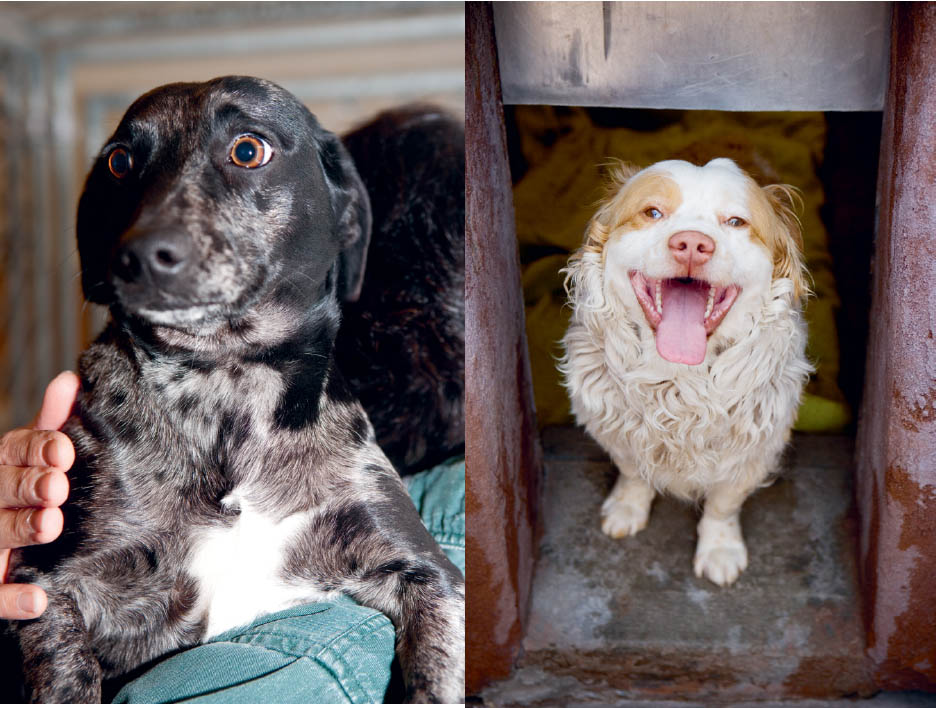
Photographing in animal shelters will give you a lot of exposure to a variety of temperaments and lots of practice for a good cause. The dog on the left was very shy (you can see the pinned-back ears and averted eyes), whereas the dog on the right was easygoing and displayed lots of excitement (with relaxed eyes and soft mouth).
Shelter animals in general are not trained, and each will respond differently to people and stimulation. In one kennel, you may interact with a very shy, timid dog; and then in the next kennel, a dog enthusiastically jumping all over you. I encourage you to consider developing a solid relationship with a shelter you’d like to support and find ways to use your creative skills in photography to help dogs (and cats) find forever homes.
Later in the book, I’ll be diving deeper into the value of photographing for nonprofits and animal welfare organizations and will offer ideas for how you might explore this in your own photography practice.

All dogs display different characteristics and are unique. If you’re going to a friend’s or client’s home to photograph, remember that you’ll want to gather some helpful information ahead of time (for more details, see chapter 6). Before photographing a dog in someone’s home environment, I’ll get a sense of the dog’s typical behavior. I try to remember to ask the pet parent if the dog is typically comfortable with strangers coming into the home. Even if the answer is yes, I still proceed with awareness. If the answer is no, I may suggest meeting at a more neutral location. Dogs can sometimes act protective of their home, car, yard, pet parent, or favorite toy. Paying attention to the body language and behavior signals I mentioned earlier can help when you engage with a dog for the first time. I’ve only encountered a couple dogs in my years of photographing who were extremely protective of their home or space; one of these occurred when I didn’t inquire about a dog’s behavior. I will not soon forget this lesson!
When entering a home for a photo shoot, I leave my equipment either in my car or outside the front door. I usually ignore the dog initially and keep my voice calm and relaxed as I chat with the owner. Sometimes I can tell immediately through body language that a dog is really comfortable and approachable, and of course, I’ll say hello and love on them. After I’ve paid close attention to their communication signals, I like to get down on their level and let them approach me. I adjust the volume and level of my voice based on the dog’s reaction to me. I don’t need to stick my hand in their face to let them smell me as they’ve already smelled me when I walked into the house. Once I bring my equipment inside, I’ll let them give that a sniff, too. If I am encountering shy dogs, I may offer them a treat to connect positivity with my presence if it feels appropriate and if I have asked the pet parent for permission.
I love photographing in and around dogs’ homes, and I make it a point to be fully prepared for a variety of behaviors.
The Value of Self-awareness
I can’t emphasize enough the value of self-awareness when photographing animals. Paying attention to your energy and maintaining awareness throughout the session will help ensure that the experience remains positive and that you get stronger photographs—and more of them. Making notes about dog behavior in general and building your toolbox of experiences when photographing pets will prove to be helpful when you’re on location. When I enter someone’s home to photograph, I am focused on getting the final images, but I’ve learned that I will be most successful if I stay aware of the energy I’m bringing into the situation and adapt accordingly rather than just barreling through.
If I am working with a shy dog and I am super hyper in my physical body language—using high-pitched sounds, making unusual noises, and popping flashes around—I’m not going to provide a fun experience for the dog, and I definitely won’t be happy with the results. I recommend that you keep gestures slow initially and pay attention to the way the dog responds when you introduce equipment, make funny noises, and create big movements.
Staying connected to the pet parent and checking in every once in a while to make sure they’re comfortable with poses, locations, and interactions is another important element of maintaining self-awareness. Sometimes I might get an idea for a photograph, but the location isn’t quite stable or large enough for the pose I want and I’ll need to let the idea go. While I may push for my ideas to come to life, I don’t choose to put dogs or people in unsafe positions or scenarios where they look uncomfortable.
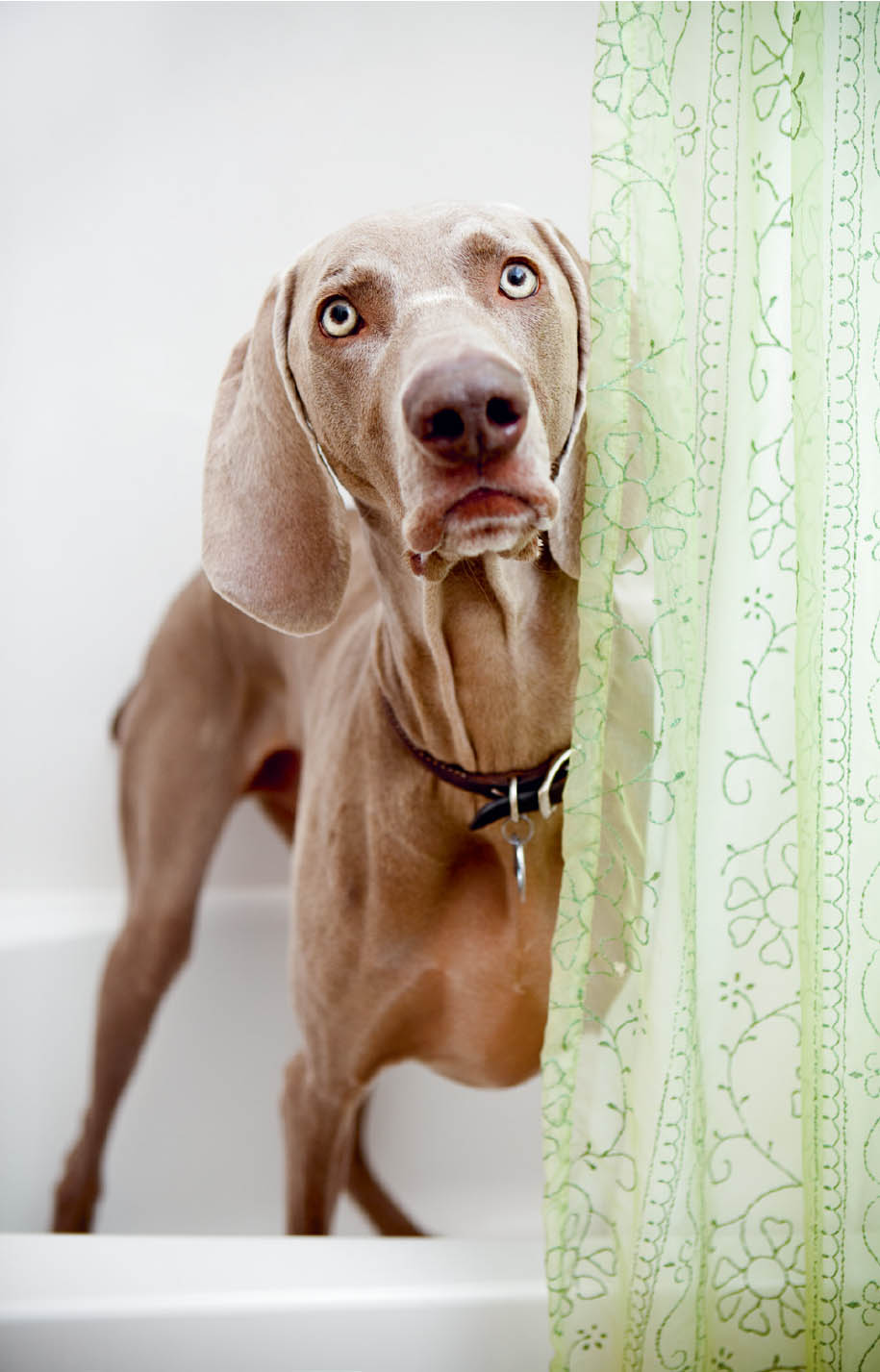
I loved photographing Simon in the bathtub, and I’m so glad I was able to discover this activity of his.
I try to practice good listening and observation skills when I’m photographing other people’s pets, because I often get ideas by doing so. For example, when photographing Simon, he ventured down the hall; and when I asked where he had gone, I was told that he loves to hang out in the bathtub—a fun and unique spot for a photograph! I had already been exploring my own ideas, but because I was listening and paying attention, I became aware of another interesting opportunity that resulted in a meaningful photograph for Simon’s owners. Many of my photographs are a result of being observant and noticing opportunities. Sometimes I’ll see a sweet gesture or action from a dog, and I’ll either be ready with my camera or I may try to get the dog to repeat the action or activity.
I often receive positive responses to my portraits, because I am told they don’t feel posed. I really appreciate getting this feedback. I wouldn’t say, however, that my photographs are entirely un-posed, because I typically have a lot of input in their creation.
My approach with more posed or stationary portraits is to control as much as I can about the environment—the lighting, location, composition, and other details—and then within that space, allow for authentic reactions and moments to occur. This applies to all of my portrait work, including dog portraits.
While I don’t love the term “static” or even “posed,” those words do provide a clear delineation between portraits and candid or action-based imagery. I gravitate aesthetically to more posed-type images for a few reasons. I find I have a little more control in the design of my frame, and I generally produce a higher ratio of successful images when I’m photographing in this way. I also love the level of engagement expressed by a dog looking directly into the camera—and in effect, to whomever is looking at the photograph. This is fun and certainly meaningful to me when I’m looking at photographs of my beloved pets.
THE UNPOSED POSE
TRY TO CREATE IMAGES THAT DON’T LOOK POSED, EVEN THOUGH YOU ARE IN CONTROL OF WHEN AND HOW THE PORTRAIT IS TAKEN. TRY THIS NEXT TIME YOU’RE ON A SHOOT: CHOOSE A LOCATION THAT HAS A CONSISTENT LIGHTING SOURCE AND ENOUGH PHYSICAL WIGGLE ROOM FOR YOU AND THE DOG. THEN PLAY WITH DIFFERENT PERSPECTIVES AND ATTENTION-GETTING TECHNIQUES, AND ALLOW FOR A LITTLE TIME TO JUST OBSERVE WITH YOUR CAMERA AND SEE WHAT UNPOSED MOMENTS PRESENT THEMSELVES.
This dog has a relaxed, natural pose as she lies on the floor in her home.
Dogs love being on beds where they’re comfortable. This also helps contain them for their portraits.
I find that working with dogs in a contained area for posed portraits helps tremendously. This can be a bed, sofa, chair, table, flowerpot, rock, porch, patio, or boat, rather than an open space where there may be a lot of distractions and opportunity to move around.
STAYING CONNECTED
One thing I’ve noticed in working with other photographers is that urge to look at every image after the shutter is pressed. When you do this, you risk wasting the dog’s energy or a special moment between dog and owner—which is no good! I try to get my exposure settings where I want them, check to see if I am happy, and then wait until after I photograph several images to see if I’m pleased with the initial results. Some amount of review does help me decide whether I want to tweak a pose or my framing or move on to a new idea. If you catch yourself over-checking your LCD, try to remember to stay as connected as possible.
FINDING VARIETY
It’s a good idea to switch physical locations frequently to keep the dog interested and engaged. Having said that, there’s a lot that can be done in one small area by switching from a sitting to a lying-down position for the dog or moving in closer to get some fun detail shots.
Changing my perspective allowed me to get a lot of variety in just one small patch of flowers when I was working with Brie.
Your choices for variety are not limited to changing physical locations—consider highlighting special features of the dog, getting creative with abstraction and focus, or capturing interaction with the pet parent or family member. Remember to pay attention to the details and what happens while you’re photographing, because it may give you additional ideas.
PRIVATE “BITS”
A QUICK NOTE ABOUT PRIVATE “BITS” AND HOW TO HIDE THEM IF YOU FEEL THEY’RE DISTRACTING: WHERE POSSIBLE, POSITION THE CAMERA’S VIEW OF THE “BITS” BEHIND ONE OF THE LEGS, OR SOME OTHER WAY VISUALLY SO THEY DON’T DRAW ATTENTION. THIS ISSUE IS NOT ALWAYS TOP-PRIORITY BUT A DETAIL THAT I THINK HELPS GUIDE THE VIEWER TO THE AREAS WHERE YOU WANT THEM TO FOCUS.
TAKING BREAKS
Breaks are important for the dog, the pet parent, and you! If you get frustrated or tired, take a break for yourself. I’d be a liar if I said I never got frustrated during a shoot. My most frustrated moments are fleeting and are usually brought on by fear of not being able to get something I’m happy with. But in the end, I’ve found that my persistence pays off if I’m willing to try lots of different approaches and regroup when needed. There’s something about this process and the results that keeps me coming back for more.
GETTING THE DOG’S ATTENTION
My objective with getting a dog’s attention is either to have them look in a specific direction or straight into the camera lens with engagement, curiosity, or just good ol’ sweetness. I want their body language, specifically their ears and eyes, to be inquisitively alert or relaxed. My favorite response (and often my clients’ favorite) when I get a dog’s attention is when they tilt their head to the side, because they can’t quite figure out where the sound I’m making is coming from.
BAG OF TRICKS
I always bring my bag of tricks to every photo shoot with a dog. This is both a physical bag filled with attention-getters, treats, and accessories, as well as a mental bag of tricks I’ve acquired from years of practice. I started with a few items and just keep adding to my bag. I try to keep the bag close to me as long as the dog doesn’t become too focused on exploring its contents or stealing my toys. If I have food in this bag, I am sure to keep it out of reach.
The key element to the bag of tricks, whether I’m dealing with verbal or physical tools, is novelty. Dogs will get desensitized to sounds, smells, tastes, and actions, and simply repeating the same action or activity will not give you good results. Novelty is key!
Remember to maintain awareness of how the dog is doing when you’re implementing attention-getters. If the dog seems scared (as seen in his or her body language and other behaviors), do not repeat the action, noise, or use of an attention-getting tool. Try shifting gears with your approach and see what happens.
Here’s what’s in my physical bag of tricks:
SQUEAKERS. These come in really handy when I am trying to grab a dog’s attention. I recommend purchasing a pack of small, plastic squeaker replacements that typically go inside dog toys. (Kong brand are usually available.) The squeaker without the toy is easier to handle, and I don’t have to worry about it not making noise when I need it to.
SQUEAKERS IN MOUTH. Anything that I can put in my mouth to make a noise is fantastic. This will leave my hands free for my camera controls. (I might drool a little when doing this, but that’s OK.) One of my pups “dissected” a rubber chicken once, and I discovered that it was much easier for me to put the squeaker in my mouth than wave a rubber chicken in the air while trying to photograph with the other. In addition, dogs often want to get toys away from you and don’t seem as interested in stealing a squeaker—I think because it’s usually harder for them to see.
MOUTH- OR SELF-GENERATED SOUNDS. This is my favorite and most-used trick in my bag, because I don’t have to hold anything in my hand, and as long as I have my voice, it’s always with me. Whispering, asking questions, using words that the pet parent has told you pique interest, clicking and animal sounds, rude-sounding noises, airy sounds, and panting sounds are all noises you can make with your mouth if you practice. You can generate tremendous variety if you’re willing to make a little bit of a fool of yourself and just have fun with it. Keep in mind that these noises don’t always have to be loud or intense, just varied and interesting to the dog.
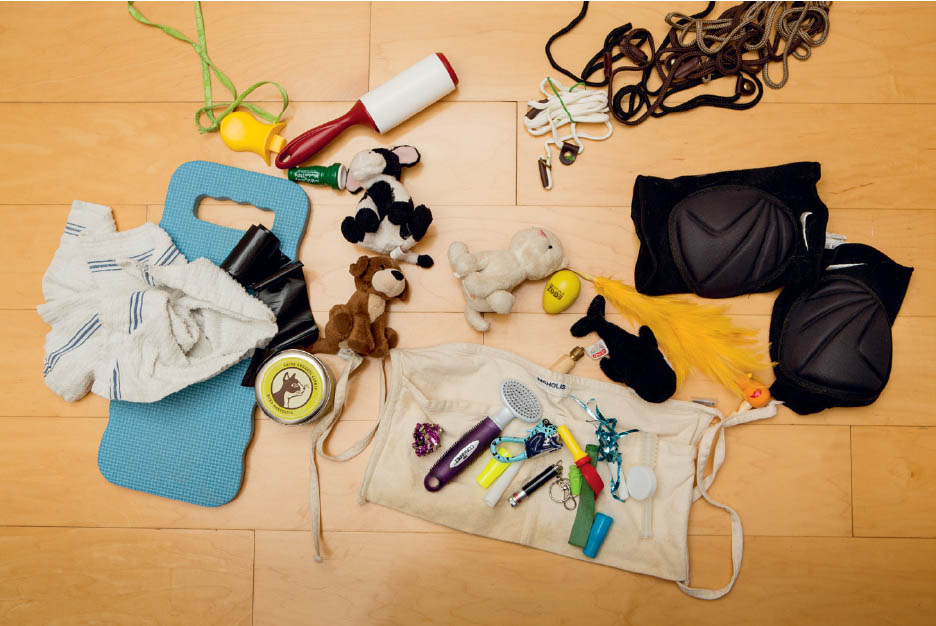
A peek into my bag of tricks.
PAPERS AND PLASTIC. Noisy materials that make rustling sounds often spark interest, usually because dogs think it might be connected to treats. Plastic bags, aluminum foil, and bubble wrap are all potential attention-getters.
NOVELTY AND TIMING ARE KEY!
REMEMBER THAT NOVELTY IS A KEY ELEMENT TO GETTING A DOG’S ATTENTION. TRY NOT TO USE THE ATTENTION-GETTER UNTIL YOU’RE REALLY READY TO TAKE THE PHOTOGRAPH SO AS NOT TO WASTE IT. TRY YOUR TRICK ONCE OR TWICE, AND SEE IF YOU GET A RESPONSE. IF NOT, MOVE ON TO A DIFFERENT APPROACH. TRY TO BE SPORADIC AND VERY INTENTIONAL ABOUT YOUR TIMING.
TREATS AND FOOD. While I often come prepared with treats (I like soft tube-style food cut up in cubes), I prefer that the pet parent provides treats to prevent upset bellies. I use treats as a last resort, because I’ve found that once I’ve introduced food, many dogs can become obsessed and intense (remember the wide eyes I referred to when discussing dog behavior earlier in this chapter?). Or they’ll excessively drool or just generally get overexcited when food is introduced—which doesn’t translate well in photographs.
If I do give treats during a shoot, I try to be sure to follow through when the dog offers the behavior I’m looking for, but will pause long enough to get a few frames. I often joke that I don’t want the word getting out amongst the other dogs in the neighborhood that I don’t follow through! If you’re really having trouble getting a dog to pay attention to your treats, consider using high-value treats. These are treats they may not typically get, like cheese or some kind of stinky food like hot dogs or liverwurst.
Choose your timing wisely with regard to attention-getting. Curiosity, which can be generated through your timing, is your friend when you’re making an effort to get a dog’s attention. I’ll often put a treat or toy behind my back and then bring it out quickly so the dog can see it. I choose to position the toy or treat right next to the lens or wherever I want the dog to gaze. This buildup of anticipation, combined with the element of surprise, can often create a brief moment when the dog will swallow and maybe tilt his head in reaction to the activity. That’s when I press the shutter. This is a great trick for creating novelty and can work well if you don’t want the dog’s tongue hanging out.
These puppies were very interested in treats and also responded well to squeaky toys.
WORDS AND OTHER SOUNDS
Words and special phrases that can evoke interest and excitement can be a really effective way to get a dog’s attention. Here are some examples:
- “Wanna go for a walk?”
- “Who’s here?”
- “Where’s Dad?”
- “Squirrel?”
- “Ball?”
- “Where’s the treat?”
- “Look!”
Because you will have asked all about the dog in your preparation time, you’ll know which words he or she responds to. Just like when we use other types of attention-getters, remember not to overuse any one particular word or phrase. If a dog is getting desensitized to the words you’re using, you’ll want to switch to something different quickly. If you notice the dog getting stressed or overly excited (to the point where it is impacting your images or the experience in a bad way), you may want to switch gears and move on to another tactic or take a break if the dog seems tired.
Some words, actions, and noises can cause the dog to run toward the camera with excitement, making it difficult to photograph. If this happens to you, notice what causes the response and either try to avoid repeating it or take advantage of the split second before he moves and then try to regroup. My preference is to make an effort to find an attention-getting technique that evokes just enough response without causing the dog to rush the camera. Also, try to avoid calling the dog’s name repeatedly, as this can get very confusing—most of us teach our dogs to come to us when we say their name. If the pet parent is helping you, be sure to communicate this politely to them.
All of these attention-getting techniques can be performed by you, an official assistant, or the pet parent, depending on how the shoot is going and what you feel is most effective given the situation. There are times when you may find more success directing the attention on your own and other times when you may really benefit from having someone else involved in the process. Pet parents have the best intentions and yet sometimes can be a distraction for the dog. If you’ve got a willing helper, it’s up to you to politely ask them to hold a toy by your camera lens or to camera right, say a special word, or just sit to the side if that seems to be most effective. Whatever you choose, be sure to communicate your needs (as mentioned in chapter 6) and give clear direction on what you want your helper to do (or not do).
There is certainly an appropriate time and place for attention-getting. If your goal is to capture portraits wherein the dog is looking straight into the camera, the likelihood that you’ll need to use some method of getting the dog’s attention is pretty high. But if the dog is scared or intimidated, you’ll want to be subdued, perhaps giving the dog some space and capturing images through a more documentary approach.
I invest significant time and energy in creating my pet portraits—I’m usually exhausted after my sessions! My goal for each photo shoot is to get as much variety as possible within a single location and to gather a small portfolio of images. For that I need persistence, which can be a good thing but can sometimes work against me. If I am really excited about a specific visual possibility, I will try my best to make it work, but if I spend an hour trying to get a dog to sit exactly how and where I want with no success, I risk missing many other images and wasting everyone’s energy. There’s a balance to achieve, and I learn something from each and every shoot.
MAKING IT PERSONAL AND SHOWING THE DOG’S UNIQUE CHARACTER
Pet portraits, in the commissioned portrait sense, are for the personal enjoyment of the pet parent. Do your best to find ways to make these portraits as personal as possible while showing the dog’s special character.
CAPTURING DETAILS
The details I’m referring to can be a physical feature on the dog, elements found in the location and environment, or something related to the pet parent’s interests. As I’m photographing in and around my client’s home, I may ask myself some questions to help generate ideas:
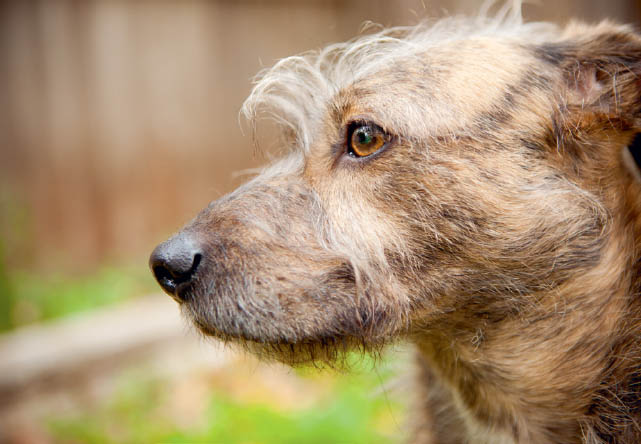
Eddie had the best fauxhawk, so I had to get a nice profile image for his parents.
- Is there a way to include details of the dog that the pet parent especially loves about him? Perhaps it’s the fur on his head, a spot on his eyes, or some other physical attribute that stands out.
- Is there an aesthetically pleasing way of using backgrounds and locations so that when the pet parent looks at these photographs years later, they are suddenly brought back to this moment via the sense of place portrayed in the images? These references can be as small as using a favorite chair or as large as an entire living room space or backyard.
- Are there elements that are personal to the pet parent that I could include to make the photographs more meaningful or fun? Maybe the pet parent has a quilt that belonged to their grandmother, or has a job as a firefighter and I can include an element of their vocation in the images—pretty fun!
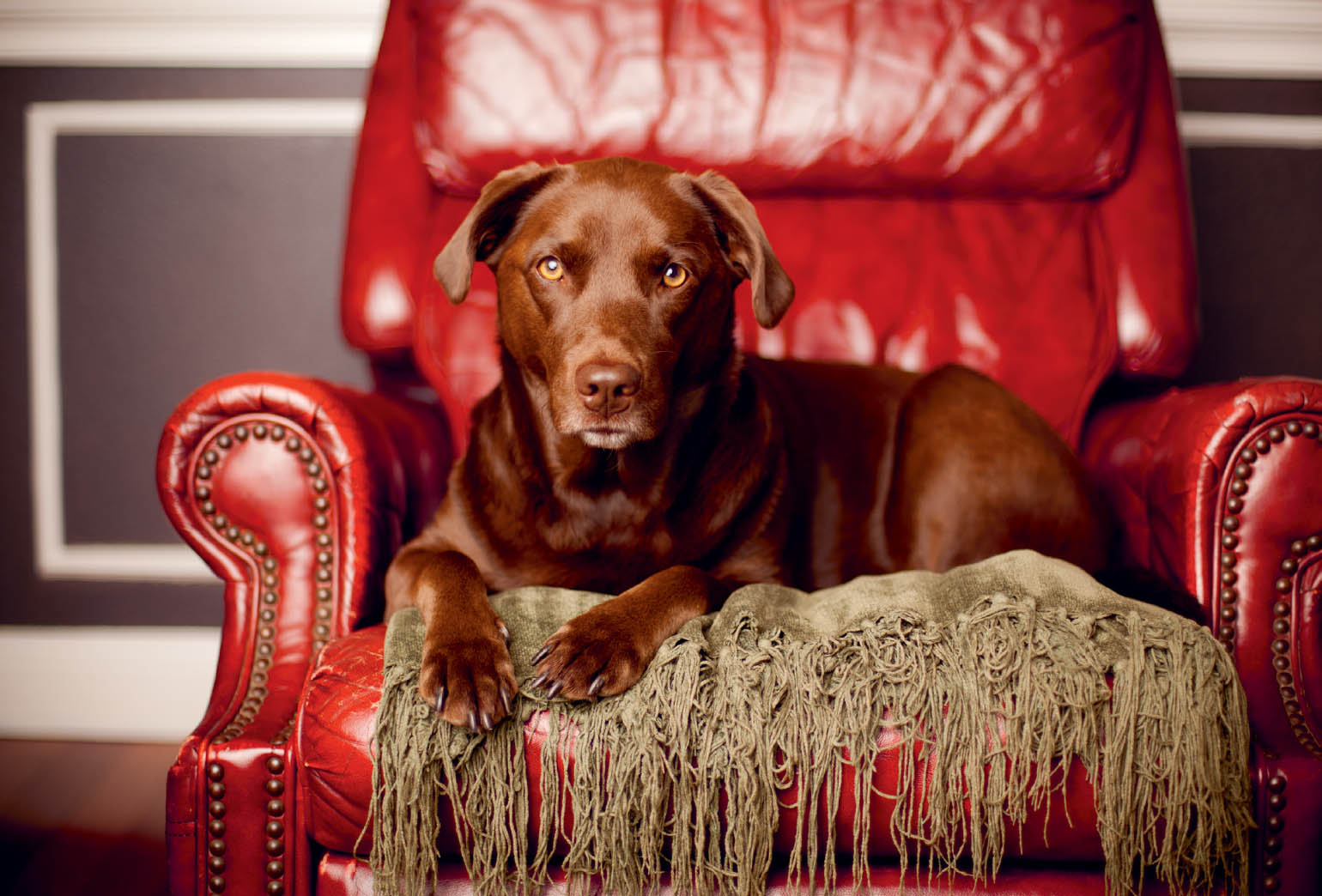
Muddy is sitting in his parent’s chair, which originally belonged to grandparents and meant something to them. I loved the color, too.
DEPTH OF FIELD
As I am working on location, I often find that playing with depth of field helps to creatively portray the personal spaces and character of a dog and their pet parent. For example, I might choose a shallow depth of field to simplify a cluttered yard or busy interior space, or to create framing devices with out-of-focus colors or shapes from elements in and around the home.
While a great depth of field can be perfect for showing lots of details, I like to use the lack of depth of field to help direct the viewer’s eye. I might direct the focus to the dog’s eyes, face, tail, or anywhere else I want the viewer to look, choosing to include just a small reference to the background or other details.
CAPTURING ACTION
While photographing action isn’t my preference for portraits, it can be refreshing to capture movement, and it’s a great way to show a dog’s unique character and energy.
BURST MODE. When I’m photographing lots of action like dogs playing, chasing balls, going after bubbles, or swimming, and my goals are to stop action, I’ll set my camera to Burst mode or rapid-fire mode. This will help ensure that I capture the point in the action I’m looking for, because it is taking multiple frames per second. I want to press the shutter button only when I think the peak of the action is occurring or about to occur. If I just hold down the shutter for hundreds and hundreds of shots, my memory card is going to fill up really quickly and I’ll have to spend a huge amount of time editing. (No, thanks!) Burst mode is a big help in action-filled circumstances, but just because I’m shooting in this way doesn’t guarantee a perfect frame—the lighting, background, composition, and gestures all have to be considered.
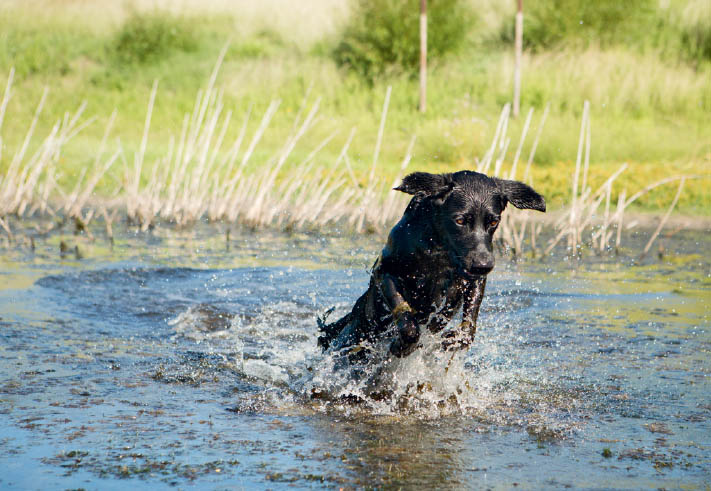
I used burst mode to take this action photograph of Friday.
TRACKING FOCUS MODE. Another big help in photographing dogs in action is to use some kind of tracking focus mode. Depending on your camera model, it may be called something different, like continuous focus. Using this mode will allow you to pick a focusing point on your camera (I usually select the center spots), and the camera will continue to very quickly refocus on the dog as long as you have the focus points aligned with the dog’s face (or wherever else you decide you want the focus point to be). Of course, you may have to physically move to keep the dog’s action within the frame, but the tracking focus tends to work much better than single focusing.
HIGH SHUTTER SPEED. If I’m interested in freezing action, I’ll want my shutter speed to be fast—set to about 1/1000 of a second or faster—for example, if I am looking to freeze droplets of water when a dog is swimming or shaking off. Even with a fast shutter speed and tracking mode, I know I may not get exactly what I want right away. If possible, I may have the dog repeat the activity so I have plenty of opportunities to get what I’m looking for. In this situation, shutter speed takes priority in terms of my settings, and I’ll select whichever aperture and ISO combination I need to ensure that my shutter speed is high enough to get the results I want.
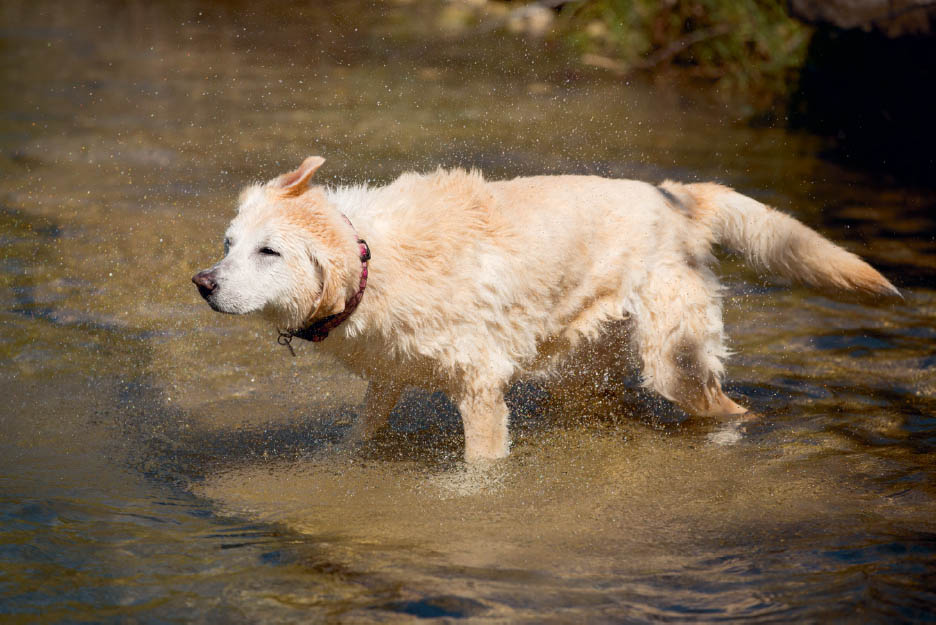
I used a very high shutter speed in this image (1/8000 of a second); you can actually see the droplets of water spraying off Hannah as she shakes.
I love the feeling of energy and movement I made in this image using the panning technique. Creating these types of images can take a little more time and can be a little unpredictable, so I typically try it when I know I’ve got what I’m looking for with regard to the other types of action shots.
SLOW SHUTTER SPEED. Freezing action isn’t the only creative choice when photographing moving dogs. Sometimes panning action can be a fun solution that can offer interesting variety. In these scenarios, I’ll use the tracking focus mode and slow my shutter speed down to maybe 1/30 or 1/15 of a second. I encourage you to experiment with all of these options for your dog portraits.
Spoiler alert: you may run into some challenges while photographing dogs. Not to worry! Here are a couple scenarios and how you might navigate your way through them.
THE DOG IS TOO FOCUSED ON THE OWNER
Dogs are bonded with their pet parent and sometimes become so focused on them that it’s difficult to capture their portrait alone. Communication is super important in these types of situations. I try to have a casual conversation with the pet parent before the shoot to let them know that if this happens, as it often does, I may ask them to step out of the room for a few moments to see if it enables me to get more direct connection from the dog. If the pet parent isn’t comfortable with leaving the dog, I’ll have him or her stand right next to me if I want the dog looking at the camera.
HIGH-ENERGY DOGS
While I love energetic dogs, a very hyper dog can be challenging to photograph. During the pre-shoot planning process, I try to find out the general energy level and age of the dog. I may suggest that the owner take the dog for a walk before the shoot if I find out that their dog is very high-energy. If that doesn’t happen and we’re in the middle of photographing and the dog is zooming around, I’ll see if the dog can “run it out” a little and settle down. If they still won’t calm down enough for stationary portraits, I’ll try to find an activity that will allow the dog to display high energy and also translates aesthetically, like swimming, running in the snow, chasing bubbles or a brightly colored ball, or engaging in a fun wrestling game with their pet parent or a toy.
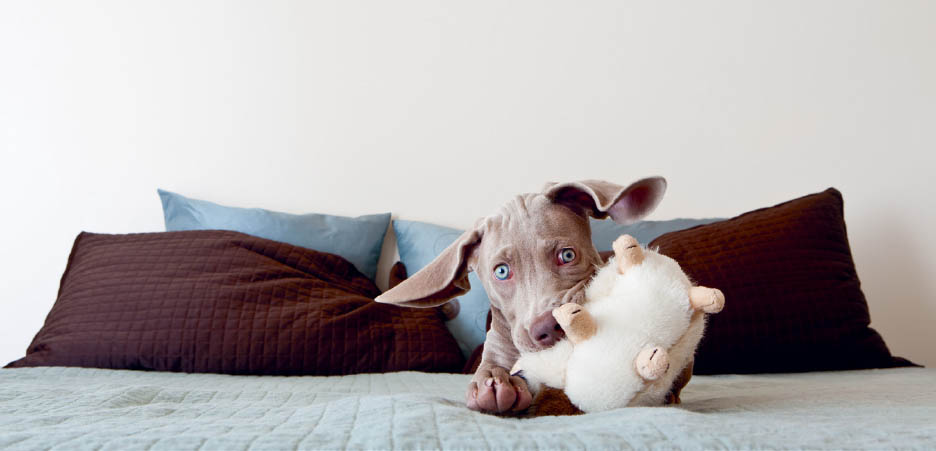
Daisy was a high-energy puppy who didn’t want to slow down for her portraits. I decided to use her energy in my favor for this image.
Having the pet parent included in the portraits can be very helpful when dealing with high-energy dogs. If the person is not excited about being photographed, you can suggest including them as a “prop” to help calm the dog, or ask that they gently cuddle the dog while only photographing a small section of them. It’s really nice to have this option.
Especially in these scenarios, be sure to give yourself plenty of time, take deep breaths, and roll with it as best you can.
LOW-ENERGY DOGS
If I encounter a low-energy dog, maybe a big, slow teddy bear or a sweet elderly dog, I’ll make sure I photograph them in a way that still honors who they are. Having said that, I still want the dog’s photograph to portray some sort of energy and vitality. I will try my best to perk them up just a little with high-value treats, words, noises, and toys. Another option to refresh a low-energy pup is to take a break with a quick walk or some other activity that he or she enjoys. Mix it up a little!
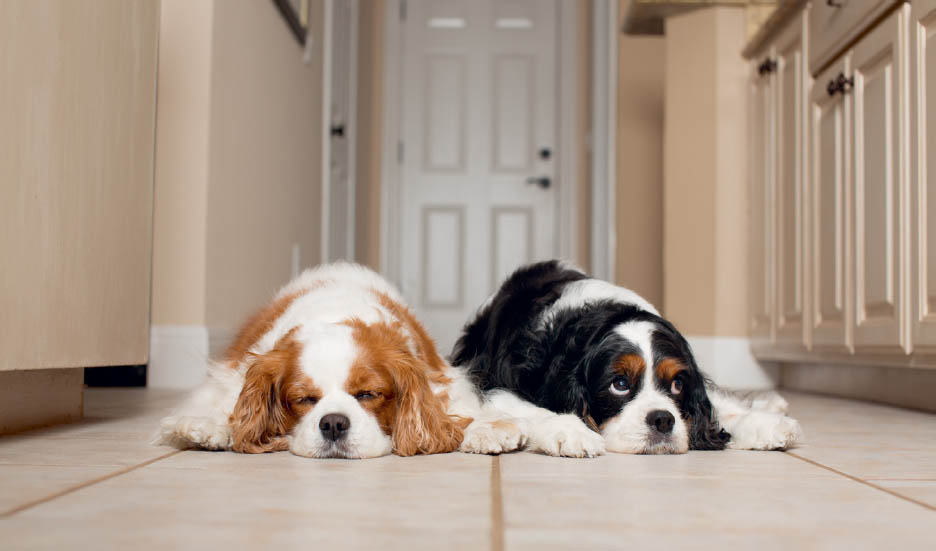
These senior ladies easily overheated and tended to move slowly. I chose to photograph them in one of their favorite spots on the cool kitchen tile and to use their peacefulness to document their typical energy.
REACTIVE OR SHY DOGS
It is possible to photograph shy dogs, but special care and extra self-awareness are required. I’ve encountered this issue frequently over the years, most often at animal shelters. (The reactive ones are typically off-limits for photographing until they can be taken through some kind of behavior training, if it’s available.)
While not always the case, I’ve found that most people who call upon photographers for portraits don’t typically have reactive dogs. If I run into situations where I am concerned for my safety, I will either not photograph or will photograph from a distance if it feels doable. Photographs are important, but so is safety.
Certain dogs may not be considered shy to their owners but will act nervous or shy around strangers. In these situations, I will be very patient and calm, keep my voice subdued, and maintain a strong sense of awareness around the dog. I’ll introduce equipment extra slowly and may even put a treat on my lens hood to associate my camera with rewards. If this approach doesn’t work and I still don’t have any photographs, I’ll use a long lens (70–200mm) and mute my camera noises so that there are no sounds coming from my camera other than the shutter. (My camera has a focus “beep” option for auto focus.) Creating a greater distance between you and the dog with a long lens is often the best solution. If you need to, you can have the pet parent and the dog engage in some kind of activity to distract the dog while you photograph.
If I encounter a dog that is afraid of the flash or large strobe, I will stop using it immediately and figure out another way to make the photo session work without the added light. I don’t think it’s worth wasting the dog’s energy or stressing a dog because of an idea I had initially.
At the end of the day (or photo shoot), we can only do our best as pet photographers—we are not magicians. Each dog and circumstance is going to be unique, and having a bunch of tools in your toolbox will set you up for success to not only troubleshoot when challenges arise, but also come out on the other side with strong imagery and pride in how you navigated the situation.
Otto was very nervous about my camera, despite my slow introduction and easy movements. I ended up photographing him with a 70–200 mm lens from across the patio.
